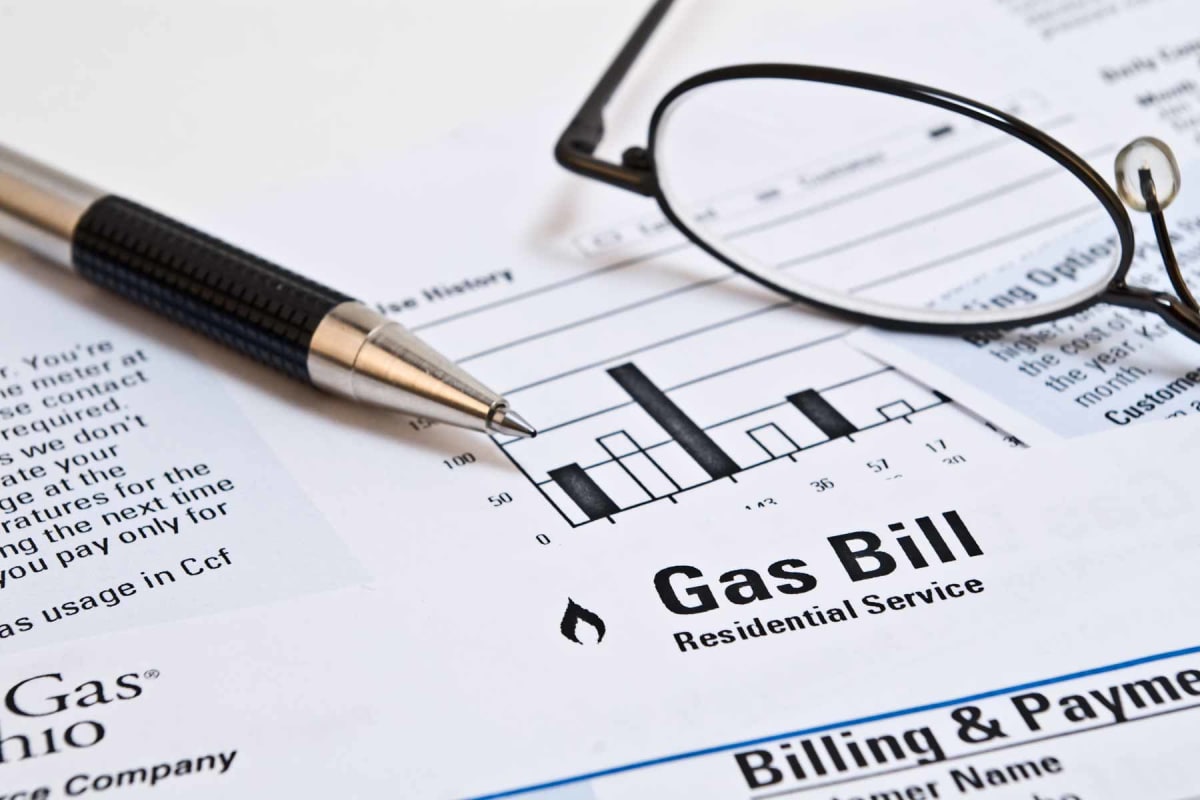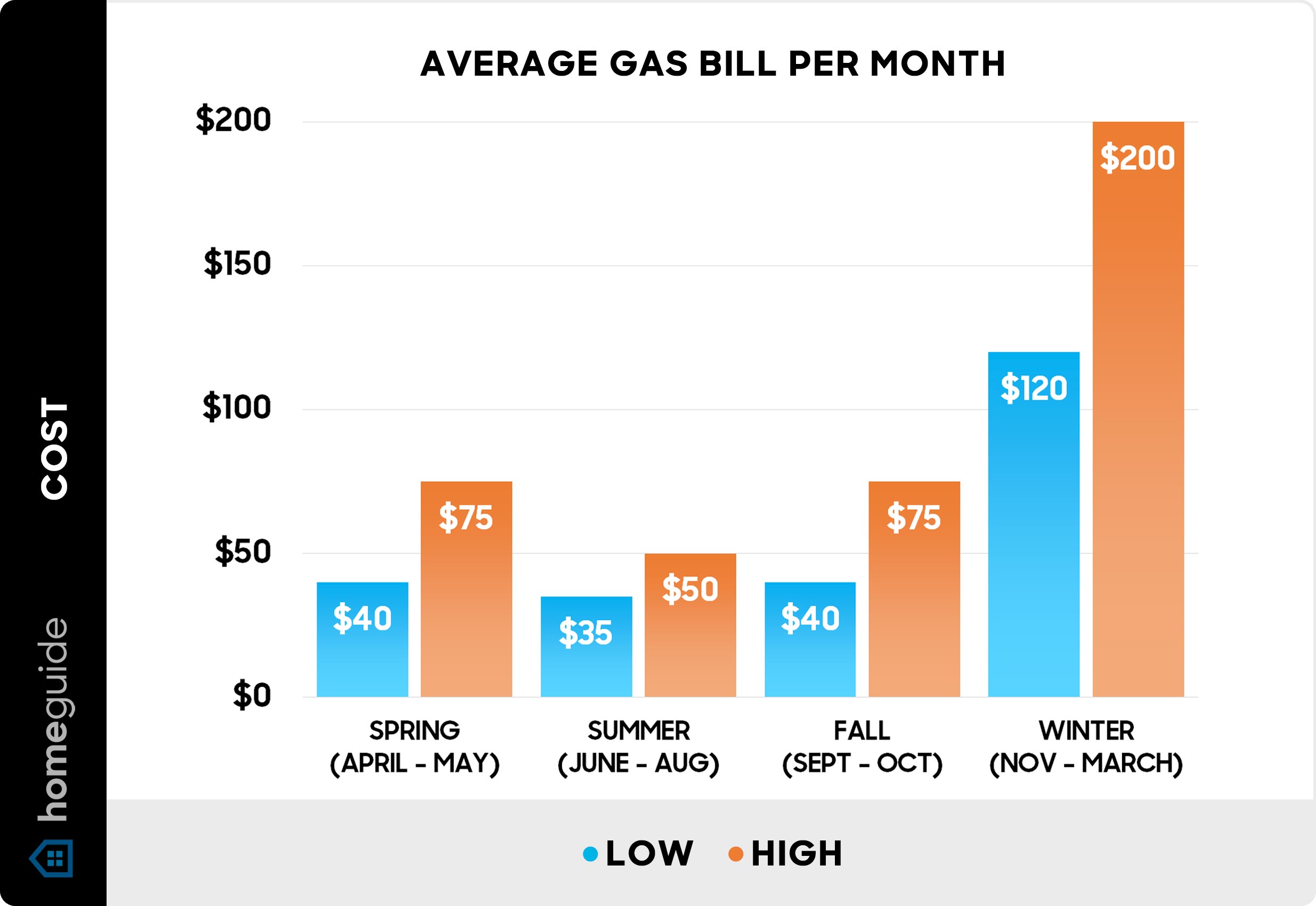
How much is the average gas bill?
How much is the average gas bill?
$40 – $75 average monthly gas bill (Spring / Fall)
$35 – $50 average monthly gas bill (Summer)
$120 – $200 average monthly gas bill (Winter)
Average gas bill
The average gas bill ranges from $35 to $200 per month, depending on the season, location and climate, your home's size and age, and your household's natural gas consumption. Average monthly gas bills are highest for homes in cold climates and households that use gas for space heating, water heating, cooking, and clothes drying.

| Season | Average monthly gas bill |
|---|---|
| Spring (April / May) | $40 – $75 |
| Summer (June through August) | $35 – $50 |
| Fall (September / October) | $40 – $75 |
| Winter (November through March) | $120 – $200 |
The average annual residential gas bill ranges from $420 to $1,600+, depending on the state.
More than 60% of U.S. households use natural gas for at least one purpose.
Average natural gas bill by state
Monthly gas bills vary by state due to differences in local gas prices and climate. Homes in states with colder weather use more gas overall for heating and typically have significantly higher gas bills in the winter than in the summer.
Natural gas prices are lowest in Montana and Idaho and highest in Florida and Hawaii. However, average monthly gas bills in Florida and Hawaii are lower than in many other states because the temperate climate means there is less need for gas heating.
| State | Average monthly gas bill* | Average gas price (per MCF) |
Average gas price (per therm) |
|---|---|---|---|
| Alabama | $55 – $70 | $23.33 | $2.25 |
| Alaska | $110 – $140 | $12.03 | $1.16 |
| Arizona | $45 – $60 | $22.96 | $2.21 |
| Arkansas | $75 – $85 | $18.55 | $1.79 |
| California | $50 – $65 | $18.41 | $1.77 |
| Colorado | $75 – $85 | $12.93 | $1.25 |
| Connecticut | $90 – $140 | $21.38 | $2.06 |
| Delaware | $75 – $100 | $22.74 | $2.19 |
| District of Columbia | $55 – $90 | $19.14 | $1.84 |
| Florida | $35 – $45 | $26.56 | $2.56 |
| Georgia | $65 – $100 | $25.19 | $2.43 |
| Hawaii | $55 – $120 | $53.46 | $5.15 |
| Idaho | $50 – $70 | $11.44 | $1.10 |
| Illinois | $95 – $120 | $15.28 | $1.47 |
| Indiana | $75 – $90 | $14.60 | $1.41 |
| Iowa | $75 – $90 | $13.99 | $1.35 |
| Kansas | $85 – $100 | $18.67 | $1.80 |
| Kentucky | $75 – $90 | $20.31 | $1.96 |
| Louisiana | $50 – $60 | $18.39 | $1.77 |
| Maine | $80 – $150 | $19.64 | $1.89 |
| Maryland | $85 – $95 | $19.32 | $1.86 |
| Massachusetts | $95 – $135 | $19.93 | $1.92 |
| Michigan | $90 – $100 | $13.04 | $1.26 |
| Minnesota | $90 – $100 | $14.40 | $1.39 |
| Mississippi | $60 – $75 | $19.69 | $1.90 |
| Missouri | $80 – $130 | $22.28 | $2.15 |
| Montana | $65 – $75 | $11.03 | $1.06 |
| Nebraska | $75 – $90 | $16.18 | $1.56 |
| Nevada | $50 – $80 | $19.95 | $1.92 |
| New Hampshire | $110 – $125 | $24.06 | $2.32 |
| New Jersey | $85 – $100 | $14.59 | $1.41 |
| New Mexico | $50 – $65 | $12.44 | $1.20 |
| New York | $81 – $120 | $18.52 | $1.78 |
| North Carolina | $75 – $85 | $21.06 | $2.03 |
| North Dakota | $80 – $95 | $14.58 | $1.40 |
| Ohio | $95 – $130 | $21.50 | $2.07 |
| Oklahoma | $75 – $100 | $21.54 | $2.08 |
| Oregon | $65 – $85 | $18.04 | $1.74 |
| Pennsylvania | $95 – $120 | $18.04 | $1.74 |
| Rhode Island | $100 – $150 | $22.72 | $2.19 |
| South Carolina | $50 – $65 | $20.43 | $1.97 |
| South Dakota | $60 – $70 | $12.10 | $1.17 |
| Tennessee | $55 – $65 | $12.81 | $1.23 |
| Texas | $55 – $75 | $21.99 | $2.12 |
| Utah | $65 – $85 | $14.47 | $1.39 |
| Vermont | $95 – $110 | $20.41 | $1.97 |
| Virginia | $80 – $95 | $19.46 | $1.87 |
| Washington | $75 – $95 | $17.48 | $1.68 |
| West Virginia | $75 – $120 | $20.91 | $2.01 |
| Wisconsin | $65 – $85 | $12.13 | $1.17 |
| Wyoming | $85 – $110 | $16.85 | $1.62 |
*Prices based on annual total household gas bills averaged across 12 months. (Data sources: U.S. Energy Information Administration and American Gas Association.)
The U.S. Energy Information Administration quotes natural gas prices per thousand cubic feet (MCF). However, residential gas bills typically measure household consumption in hundred cubic feet (CCF) or therms. Use this formula to convert gas prices from one unit of measurement to another:
1 MCF = 10 CCF = 10.38 therms
Why is my gas bill so high?
In addition to the gas prices in your state, these other factors also impact your home's energy use and may contribute to high gas bills:
Home & household size: Larger homes and households typically use more natural gas for home heating and water heating, resulting in higher bills.
Usage: Though home heating and water heating are the most common household uses for natural gas, many people also use it for outdoor grilling, clothes drying, fireplaces, standby generators, and heating swimming pools or hot tubs. The more gas your household uses, the higher your bills will be.
Season & weather: Gas bills are typically higher in winter due to increased usage for heating, especially in cold climates.
Outdated or inefficient heating system: Home heating is the single largest use of natural gas in residential homes, accounting for 35% to 50% of your total gas bill. If your furnace or other heating system components are old, inefficient, or need maintenance, they'll consume more gas and increase your bills.
Water heating: In homes with gas water heaters, water heating accounts for 18% to 20% of the total natural gas usage. Old water heaters are less efficient and use far more gas than newer models.
Insulation: Up to 90% of U.S. homes are under-insulated. Old or inadequate insulation forces your heating system to work harder to keep your home warm, causing higher gas bills.
Generator: Many whole-house and standby generators use natural gas to keep the electricity running during a power outage. If an outage causes your generator to run, you'll see an increase in your gas bill that month.
Taxes & fees: Your gas bill also includes additional charges for federal and local taxes and fees, including utility taxes, pipeline usage fees, tariffs, excise taxes, and sales and use taxes.
If your gas bill is higher than expected, compare it to average bills in your region and to your previous gas bills to see how the gas prices and total consumption differ. Sudden spikes in usage or drastic increases compared to the previous year's bills may indicate problems with your heating system or water heater.

How to lower your gas bill
Making simple changes to your household's habits can reduce your gas bills. In addition, the average family can save a significant amount on annual gas expenses with energy-efficient home improvement projects like adding insulation or weatherstripping.
Turn down your thermostat: Lowering the temperature on your thermostat can save you 3% per degree.
Take advantage of natural heat: Open the window curtains or blinds during the day on the sides of your home that are exposed to the sun, and close them when it gets dark to reduce heat loss.
Turn down the water temperature: You'll save 3% to 5% on water heating costs for every 10-degree reduction in the temperature on your water heater tank.
Add weatherstripping: Weatherstripping is a low-cost solution that reduces heat loss by sealing the gaps around windows and doors to prevent air from entering or exiting. Weatherstripping costs $130 to $470 for an average home.
Add insulation: Adding insulation can reduce your energy costs by 10% to 40%. Insulation costs $1.00 to $4.50 per square foot with professional installation. Prices depend on the insulation material, R-value, and which part of the house you're insulating.
Maintain your HVAC system: Clean or replace the filters on your furnace regularly and keep the vents or radiators throughout your home clean and unobstructed. Dirty filters and blocked vents force the heating system to work harder and use more energy.
Replace old, inefficient windows: New double-pane and triple-pane windows are 30% to 50% more energy efficient than old single-pane windows. Window replacement costs $450 to $1,500 per window on average.
Upgrade to energy-efficient appliances: Replace old, inefficient gas water heaters, ovens, and clothes dryers with new ENERGY STAR-rated models.
To learn more about other utility costs, check out these other guides: